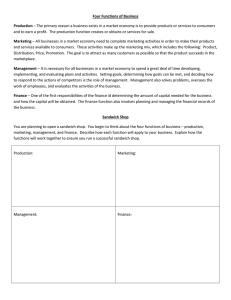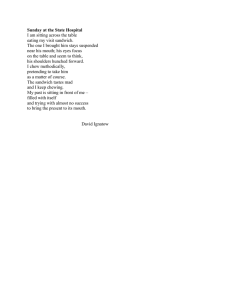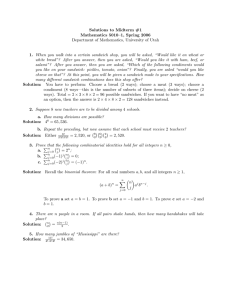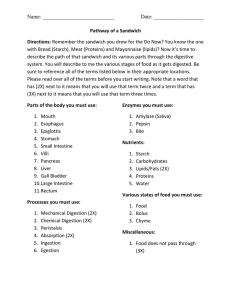Design and Analysis of Stainless Steel and Mild Steel
advertisement
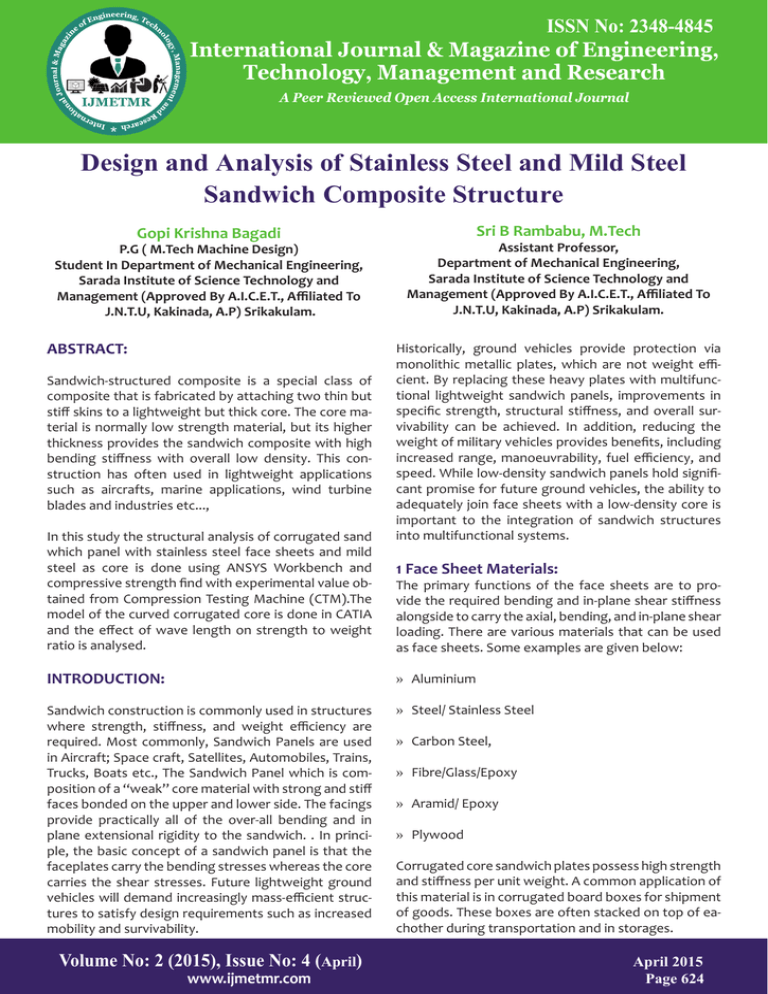
ISSN No: 2348-4845 International Journal & Magazine of Engineering, Technology, Management and Research A Peer Reviewed Open Access International Journal Design and Analysis of Stainless Steel and Mild Steel Sandwich Composite Structure Gopi Krishna Bagadi P.G ( M.Tech Machine Design) Student In Department of Mechanical Engineering, Sarada Institute of Science Technology and Management (Approved By A.I.C.E.T., Affiliated To J.N.T.U, Kakinada, A.P) Srikakulam. ABSTRACT: Sandwich-structured composite is a special class of composite that is fabricated by attaching two thin but stiff skins to a lightweight but thick core. The core material is normally low strength material, but its higher thickness provides the sandwich composite with high bending stiffness with overall low density. This construction has often used in lightweight applications such as aircrafts, marine applications, wind turbine blades and industries etc..., In this study the structural analysis of corrugated sand which panel with stainless steel face sheets and mild steel as core is done using ANSYS Workbench and compressive strength find with experimental value obtained from Compression Testing Machine (CTM).The model of the curved corrugated core is done in CATIA and the effect of wave length on strength to weight ratio is analysed. Sri B Rambabu, M.Tech Assistant Professor, Department of Mechanical Engineering, Sarada Institute of Science Technology and Management (Approved By A.I.C.E.T., Affiliated To J.N.T.U, Kakinada, A.P) Srikakulam. Historically, ground vehicles provide protection via monolithic metallic plates, which are not weight efficient. By replacing these heavy plates with multifunctional lightweight sandwich panels, improvements in specific strength, structural stiffness, and overall survivability can be achieved. In addition, reducing the weight of military vehicles provides benefits, including increased range, manoeuvrability, fuel efficiency, and speed. While low-density sandwich panels hold significant promise for future ground vehicles, the ability to adequately join face sheets with a low-density core is important to the integration of sandwich structures into multifunctional systems. 1 Face Sheet Materials: The primary functions of the face sheets are to provide the required bending and in-plane shear stiffness alongside to carry the axial, bending, and in-plane shear loading. There are various materials that can be used as face sheets. Some examples are given below: INTRODUCTION: »» Aluminium Sandwich construction is commonly used in structures where strength, stiffness, and weight efficiency are required. Most commonly, Sandwich Panels are used in Aircraft; Space craft, Satellites, Automobiles, Trains, Trucks, Boats etc., The Sandwich Panel which is composition of a “weak” core material with strong and stiff faces bonded on the upper and lower side. The facings provide practically all of the over-all bending and in plane extensional rigidity to the sandwich. . In principle, the basic concept of a sandwich panel is that the faceplates carry the bending stresses whereas the core carries the shear stresses. Future lightweight ground vehicles will demand increasingly mass-efficient structures to satisfy design requirements such as increased mobility and survivability. »» Steel/ Stainless Steel Volume No: 2 (2015), Issue No: 4 (April) www.ijmetmr.com »» Carbon Steel, »» Fibre/Glass/Epoxy »» Aramid/ Epoxy »» Plywood Corrugated core sandwich plates possess high strength and stiffness per unit weight. A common application of this material is in corrugated board boxes for shipment of goods. These boxes are often stacked on top of eachother during transportation and in storages. April 2015 Page 624 ISSN No: 2348-4845 International Journal & Magazine of Engineering, Technology, Management and Research A Peer Reviewed Open Access International Journal 2 Core Materials: The core has several vital functions. It must be stiff enough to resist loads acting in perpendicular direction to the panels, so the distance between the upper and lower face sheet remains fixed. Also, it must be stiff enough in shear to prevent the sliding of the face sheets over each other. If this condition is not fulfilled, the face sheets act as two independent panels and the sandwich effect is lost. a) Corrugated core b) foam core In addition, the core should be stiff enough to stabilize the thin face sheets, otherwise wrinkling (local buckling) of the face sheets may occur. Further, it increases the moment of inertia of the cross section of the outer faces and enables them to Work together as a single beam. Both the critical buckling stress and the ultimate compressive strength of the compressed face are significantly raised by the presence of the core in comparison to similar plates without such support. c) Honeycomb core d) truss core DIFFERENT TYPES OF CORE IN SANDWICH STRUCTURES 3 Composite sandwich structures: Composite materials consist of two or more different materials bonded to each other in order to utilize the properties of each constituent for the structural improvement of the whole assembly. Composite materials prevail over traditional monolithic engineering materials as they offer several advantages such as high strength, high stiffness, long fatigue life, low density, wear and corrosion resistance and acoustic insulation. The reason that composites have superior structural performance is their high specific strength (strength to density ratio) and high specific stiffness (modulus to density ratio). There are three main classifications of composite materials: particle-reinforced, fibre-reinforced, and structural composites. Volume No: 2 (2015), Issue No: 4 (April) www.ijmetmr.com In particle-reinforced composites, particle dimensions are approximately the same in all directions and generally particulate phase is harder and stiffer than the matrix. In fibre-reinforced composites, the dispersed phase has the geometry of a fibre, the mechanical properties mostly depend on the properties of the fibres and applied load is transmitted to the fibres by the matrix phase through the fibre/matrix interface. Structural composites are the combinations of composites and homogeneous materials and the geometrical design of the structural elements affect the mechanical properties of the structure. The most common structural composites are laminated composites and sandwich panels April 2015 Page 625 ISSN No: 2348-4845 International Journal & Magazine of Engineering, Technology, Management and Research A Peer Reviewed Open Access International Journal Composite sandwich panel LITERATURE REVIEW: Noor, Burton and Bert state that the concept of sandwich construction dates back to Fairbairn in England in 1849. Also in England, sandwich construction was first used in the Mosquito night bomber of World War II which employed plywood sandwich construction. Feichtinger states also that during world war II, the concept of sandwich construction in the United States originated with the faces made of reinforced plastic and low density core. In 1951, Bijlaard studied sandwich optimization for the case of a given ratio between core depth and face thickness as well as for a given thickness[1] Various analyses on sandwich structure are Kevin J. Doherty investigate sandwich panels of metallic face sheets and a pyramidal truss core subjected to panel bending and in plane compression testing to explore the effects of relative core density and process parameters.[2]. Aydıncak, İlke made a design and analysis of honeycomb structures to develop an equivalent orthotropic material model that is substitute for the actual honeycomb core.[3] . Jukka Säynäjäkangas make a review in design and manufacturing of stainless steel sandwich panels and conclude an efficient sandwich is obtained when the weight of the core is close to the combined weight of the both faces[4]. Tomas Nordstrand made an analysis on corrugated board in three-pointbending and evaluation of the bending stiffness and the transverse shear stiffness[5]. Pentti Kujala discussed that steel sandwich panels that are welded by laser can save 30-50% weight compared to conventional steel structures[6].Jani Romanoff presents a theory of bending of laser welded web core sandwich panels by considering factors that effect the total bending response of laser welded web core sandwich plates[7]. Pentti Kujala made analysis on metallic sandwich panels which are laser welded have excellent properties with light weight having more applications[8].Narayan Pokharel determined local buckling behavior of fully profiled sandwich panels which are based on polyurstyrene foam and thinner and high strength steels[9]. Pentti kujala determined ultimate strength of all steel sandwich panels and numerical FEM analysis and development of design formulations for these panels.[10]. EXPERIMENTAL ANALYSIS OF SANDWITCH COMPOSITE: Compression Experiment: Steel sandwich structure with stainless steel faces and mild steel core are joined by welding and the inplane compression test of sandwich structure was performed on compression testing machine (CTM) having capacity 5000KN. The samples were placed between hardened end plates in order to protect the surface of the machine’s platens. Load is applied uniformly and deflection and compression strength are noted. Sample preparation Fig Stainless steel face and mild steel core Volume No: 2 (2015), Issue No: 4 (April) www.ijmetmr.com Welded steel sandwich composite structure April 2015 Page 626 ISSN No: 2348-4845 International Journal & Magazine of Engineering, Technology, Management and Research A Peer Reviewed Open Access International Journal Steel sandwich structure with two stainless steel faces, top and bottom in between mild steel core are joined by welding as shown in the Fig. Test set-up, specification of m/c and specimen details: A compression test can be performed on CTM by keeping the test-piece on base block (see in fig.) and moving down the central grip to apply load. It can also be performed on a compression testing machine. A compression testing machine shown in fig. it has two compression plates/heads.The upper head moveable while the lower head is stationary. One of the two heads is equipped with a hemispherical bearing to obtain. Uniform distribution of load over the test-piece ends. A load gauge is fitted for recording the applied load. Sandwich core composite testing the compressive strength using by Compressive testing machine(CTM) as shown in Fig. compression testing on CTM machine Result:The load carrying of given specimen = 3000 N DESIGN AND ANALYSIS OF SANDWITCH COMPOSITE 1. CATIA (Computer Aided Three-dimensional Interactive Application): CATIA (Computer Aided Three-dimensional Interactive Application) (in English usually pronounced /kti/) is a multiplatform CAD/CAM/CAEcommercial software suite developed by the French company DassaultSystèmes directed by Bernard Charles. Written in the C++ programming language, CATIA is the cornerstone of the Dassault Systems software suite. CATIA (computer aided three-dimensional interactive application) started as an in-house development in 1977 by French aircraft manufacturer avions marcel dassault, at that time customer of the cad/cam cad software[1] to develop dassault’s mirage fighter jet. it was later adopted in the aerospace, automotive, shipbuilding, and other industries. Volume No: 2 (2015), Issue No: 4 (April) www.ijmetmr.com initially named CATI (conception assistéetridimensionnelle interactive – French for interactive aided three-dimensional design ), it was renamed catia in 1981 when dassault created a subsidiary to develop and sell the software and signed a non-exclusive distribution agreement with IBM.Commonly referred to as a 3D Product Lifecycle Management software suite, CATIA supports multiple stages of product development (CAx), including conceptualization, design (CAD), engineering (CAE) and manufacturing (CAM). CATIA facilitates collaborative engineering across disciplines around its 3DEXPERIENCE platform, including surfacing & shape design, electrical fluid & electronics systems design, mechanical engineering and systems engineering.CATIA facilitates the design of electronic, electrical, and distributed systems such as fluid and HVAC systems, all the way to the production of documentation for manufacturing. 2. ANSYS Workbench: ANSYS Work bench can be thought of as a software platform or framework where you perform your analysis (Finite Element Analysis) activities. April 2015 Page 627 ISSN No: 2348-4845 International Journal & Magazine of Engineering, Technology, Management and Research A Peer Reviewed Open Access International Journal In other words, workbench allows you to organize all your related analysis files and databases under same frame work. Among other things, this means that you can use the same material property set for all your analyses. Some of the applications that fit into the workbench framework are: Analysis of sandwich structure in various cases Case 1: 1. Design modeller 2.Mechanical (simulation) 3.Design Xplorer 4.AUTODYN 5.CFX Mesh 6.FE Modeler Assembly of Sandwich structure The ANSYS Workbench platform allows users to create new, faster processes and to efficiently interact with other tools like CAD systems. In this platform working on Multiphysics simulation is easy. Those performing a structural simulation use a graphical interface (called the ANSYS Workbench Mechanical application) that employs a tree-like navigation structure to define all parts of their simulation: geometry, connections, mesh, loads, boundary conditions and results.By using ANSYS workbench the user can save time in many of the tasks performed during simulation. The bidirectional links with all major CAD systems offer a very efficient way to update CAD geometries along with the design parameters. Sandwich panels are modeled in CATIA V5. Then the total part is saved in IGS format and imported to ANSYS workbench. In ANSYS Workbench the IGS format is Imported and geometry will show three contact pairs. Materials properties are given to the individual part i.e, top and bottom plates are selected and stainless steel properties are given to them. Now core is selected and mild steel properties are given. now mesh the geometry as free mapped mesh and structural analysis is done by fixing the plate at bottom and pressure is applied at top face of the plate as shown in fig. now by solving the structure the deflection and von misses stress are noted. By changing the wave length of corrugated core and same is modeled and analyzed at a constant pressure the variation in deflection and von misses are compared. Volume No: 2 (2015), Issue No: 4 (April) www.ijmetmr.com Meshing of Sandwich Structure Total deformation of sandwich structure April 2015 Page 628 ISSN No: 2348-4845 International Journal & Magazine of Engineering, Technology, Management and Research A Peer Reviewed Open Access International Journal Equivalent stress of sandwich structure Equivalent stress of sandwich structure Case 4:-Two faces between height decreases 40 mm to 20mm Case 2:-Face thickness increases 2 mm to 4 Total deformation of sandwich structure Total deformation of sandwich structure Equivalent stress of sandwich structure Equivalent stress of sandwich structure Case 3:-Core thickness decreases 5 mm to 3mm Case 5:-Same material (Stainless steel) of Sandwich structure Total deformation of sandwich structure Total deformation of sandwich structure Volume No: 2 (2015), Issue No: 4 (April) www.ijmetmr.com April 2015 Page 629 ISSN No: 2348-4845 International Journal & Magazine of Engineering, Technology, Management and Research A Peer Reviewed Open Access International Journal Select total deformation Equivalent stress of sandwich structure Select Equivalent stress Case 6:-Different forces applied on sandwich composite 1000 N, 2000 N and 3000 N Select total deformation Select Equivalent stress Select total deformation Select Equivalent stress Result and Discussion Analysis of sandwich structure in different cases Volume No: 2 (2015), Issue No: 4 (April) www.ijmetmr.com April 2015 Page 630 ISSN No: 2348-4845 International Journal & Magazine of Engineering, Technology, Management and Research A Peer Reviewed Open Access International Journal Table shows Comparison of sandwich core in different cases Sandwich composite experimentally result on CTM Specimen resistance load Table shows the total deformation and equivalent stress changes as comparison with actual taken sandwich composite structure Conclusion: The sandwich composite structure model in CATIA V5 and efficiently imported into ANSYS workbench then structural analysis is done to find the equivalent stress and total deformation is observed in various cases. In the composite structure the equivalent stress as well as total deformation is also changes compare to dimensions (i.e. face, core, and height) changed structures, various loads applied structures and material changed structures. »» Sandwich structure composite face thickness doubled then total deformation decreases 80 % and equivalent stress decreases 75 %. »» Sandwich structure composite faces between distances doubled then total deformation increases 35 % and equivalent stress increases15 %. »» Sandwich structure composite applied load changes (increases) then total deformation increases and equivalent stress increases. »» Sandwich composite structure (Face- stainless steel & Core – mild steel) equivalent stress decreases by around 0.4% and Total deformation increases 0.3 % and weight is decreases by around 20% as compare stainless steel structure. »» Sandwich structure composite core thickness doubled then total deformation decreases 15 % and equivalent stress decreases 3 %. Volume No: 2 (2015), Issue No: 4 (April) www.ijmetmr.com April 2015 Page 631 ISSN No: 2348-4845 International Journal & Magazine of Engineering, Technology, Management and Research A Peer Reviewed Open Access International Journal [6] Pentti kujala, Alan Klanac,” Steel Sandwich Panels in Marine Applications” PrihvaÊeno, 2005-05-05 References: [1] O.T. Thomson et al.(eds), sandwich structures 7; advancing with Sandwich Structure and materials, 3-12 [2] Kevin J. Doherty, Aristedes Yiournas, Jordan A.Wagner, and Yellapu Murty, “Structural Performanc of Aluminum and Stainless Steel Pyramidal Truss Core Sandwich Panels” ,ARL-TR-4867 July 2009. [3] Aydıncak, İlke ” investigation of design and analyses principles of honeycomb structures” [4] Jukka Säynäjäkangas and Tero Taulavuori, Outokumpu Stainless Oy, Finland “A review in design and manufacturing of stainless steel sandwich panels” stainless steel world oktober 2004 [7] Jani Romanoff “Bending Response of LaserWelded Web-Core Sandwich Plates”ISSN (printed) 1795-2239 [8] Pentti Kujala “Steel Sandwich Panels – From BasicResearch To Practical Applications” 2Vol. 16/ISSN 0784-6010 2002 [9] Narayan Pokharel and Mahen Mahendran “Finite Element Analysis and Design of Sandwich Panels Subject to Local Buckling Effects” [10] Pentti kujala “ultimate strength analysis of all steel sandwich panels”Rakenteiden Makaniikka,vol.31 Nrot 1-2,1998,s. 32-45 [5] Tomas Nordstrand,” Basic Testing And Strength Design Of Corrugated Board And Containers” Division of Structural Mechanics, LTH, Lund University, Box 118, SE-221 00 Lund, Sweden. Volume No: 2 (2015), Issue No: 4 (April) www.ijmetmr.com April 2015 Page 632
